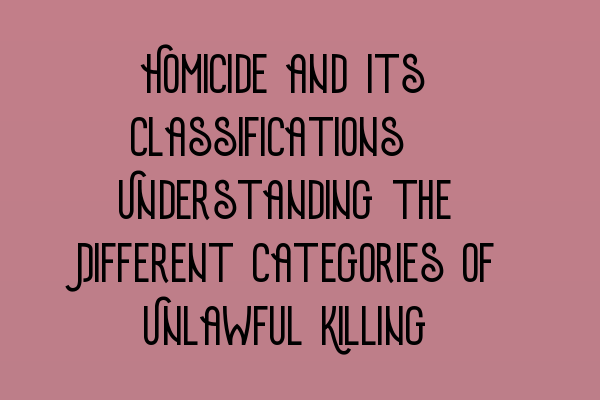Homicide and Its Classifications: Understanding the Different Categories of Unlawful Killing
As criminal law practitioners at SQE Criminal Law & Practice Law UK, we understand the complexity and gravity of homicide cases. Homicide refers to the unlawful killing of a human being, and it is a serious offense that carries severe penalties. In this blog post, we will delve into the classifications of homicide, helping you gain a deeper understanding of the different categories of unlawful killing.
Murder
Murder is the most severe classification of homicide. It occurs when an individual intentionally causes the death of another person with malice aforethought. Malice aforethought refers to the deliberate intention to cause serious harm or take a person’s life. Murder cases require a proving of both intent and malice aforethought, and the penalties for murder can include life imprisonment.
If you are preparing for the SQE 1 exam, don’t forget to check out our SQE 1 Practice Exam Questions article to enhance your knowledge and test your understanding of criminal law concepts.
Voluntary Manslaughter
Voluntary manslaughter occurs when an individual causes the death of another person but without the premeditated intent to kill or inflict serious harm. This category of unlawful killing often emerges from sudden provocation or heat of passion, where a person’s emotions overwhelm their ability to reason. Penalties for voluntary manslaughter vary, but they are generally less severe than those for murder.
Involuntary Manslaughter
Involuntary manslaughter refers to unintentional killings that result from reckless or negligent behavior. Unlike murder and voluntary manslaughter, there is no requirement for malice aforethought or intent to cause harm. In these cases, the individual responsible did not intend to kill but acted recklessly or negligently, resulting in someone’s death. The penalties for involuntary manslaughter depend on the circumstances surrounding the killing, with sentences ranging from fines to imprisonment.
For additional SQE exam preparation resources, consider exploring our SQE 1 Practice Mocks FLK1 FLK2 to familiarize yourself with mock exam scenarios and assess your readiness for the SQE 1 exam.
Infanticide
Infanticide is a unique category of unlawful killing that involves the killing of an infant aged 12 months or younger by their mother. It is essential to note that infanticide offenses recognize the postpartum mental state of the mother as a contributing factor. The penalties for infanticide are generally less severe than those for murder or manslaughter, taking into account the complex circumstances surrounding such cases.
Conclusion
Understanding the classifications of homicide is crucial for criminal law practitioners and aspiring legal professionals. While this blog post provides a brief overview, it is essential to consult legal resources and seek expert advice to gain a comprehensive understanding of the subject matter.
For comprehensive preparation for the SQE exams, including criminal law topics, be sure to explore our SQE 2 Preparation Courses tailored to help you succeed in your legal career. Additionally, our SQE 1 Preparation Courses offer comprehensive study materials and support.
Stay updated with important SRA SQE exam dates by checking out our informative article on SRA SQE Exam Dates.
At SQE Criminal Law & Practice Law UK, we are committed to providing the best resources and support for legal professionals and students. Keep learning, stay informed, and excel in your legal career!
